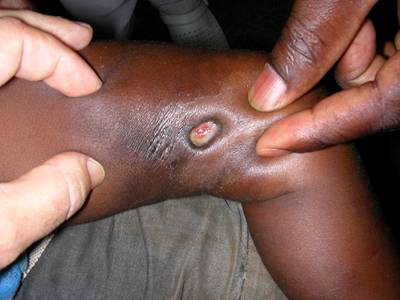Buruli Ulcer Diagnosed by Fluorescent Thin Layer Chromatography
By LabMedica International staff writers
Posted on 29 Nov 2015
Mycobacterium ulcerans infection, known as Buruli ulcer, is a disease of the skin and subcutaneous tissues which is an important but neglected tropical disease with its major impact in rural parts of West and Central Africa where facilities for diagnosis and management are poorly developed. Posted on 29 Nov 2015
Since prevention is not possible in the absence of either an effective vaccine or a clear understanding of the mode of transmission, a major control strategy for Buruli ulcer is early detection and treatment, hinging on effective laboratory confirmation of suspected cases. Standard routine laboratory techniques for the confirmation of Buruli ulcer disease are M. ulcerans isolation by culture, histopathology, smear microscopy for acid-fast bacilli (AFB) and polymerase chain reaction (PCR).

Image: A small Buruli ulcer caused by Mycobacterium ulcerans (Photo courtesy of Dr. A. Chauty, AFRF, Benin).
A team of international scientists led by those at Kwame Nkrumah University of Science and Technology (KNUST) (Kumasi, Ghana) recruited patients from Buruli ulcer treatment centers from January 2014 to June 2014 in Benin, DR Congo, Ghana and Côte d’Ivoire if they had a skin lesion suspected to be caused by M. ulcerans infection. Samples were collected by fine needle aspiration (FNA) or swab according to whether the lesion was non-ulcerated or ulcerated respectively and by biopsy if obtained at surgery. If PCR for the M. ulcerans repeat sequence IS2404 was positive they were included as Buruli ulcer disease patients and if the PCR was negative they were included in the control group.
The team evaluated fluorescent thin layer chromatography (f-TLC) for detection of mycolactone in the laboratory using samples from patients with Buruli ulcer and patients with similar lesions that gave a negative result on PCR. The f-TLC used was a modification of an existing methodology. The TLC plates were placed on an ultra violet lamp with a 365 nm filter. The fluorescent band at retention factor 0.23 from the patient sample was compared to that of the standards to confirm the presence of mycolactone. Two readers were made to confirm the mycolactone test result before test result reporting and were blinded to the PCR test result.
There were 71 IS2404 PCR positive samples and 28 PCR negative samples which were used as controls. The scientists found that mycolactone can be detected in 73% of M. ulcerans infected samples by fluorescent thin layer chromatography. The technique was easy to perform and the result could be read within one hour. The sensitivity was higher than that of microscopy (30–60%) or culture (35%–60%) and compared favorably with that of histology (82%). There was no difference in sensitivity when FNA and swabs were compared although the number of FNA samples was small.
The authors concluded that that mycolactone can be detected from M. ulcerans infected skin tissue by f-TLC technique. The technique is simple, easy to perform and read with minimal costs. In this study it was undertaken by a member of the group from each endemic country. It is a potentially implementable tool at the district level after evaluation in larger field studies. The study was published on November 19, 2015, in the journal Public Library of Science Neglected Tropical Diseases.
Related Links:
Kwame Nkrumah University of Science and Technology







 Analyzer.jpg)





